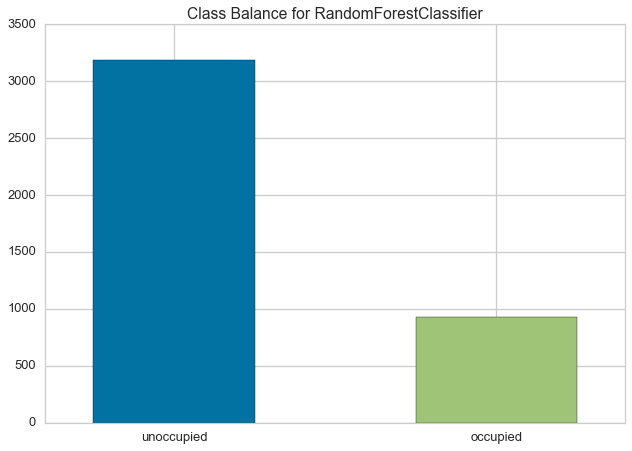Methods¶
Here is a walkthrough of some of the data and model visualization methods that are currently implemented in yellowbrick.
import os
import sys
# Modify the path
sys.path.append("..")
import pandas as pd
import yellowbrick as yb
import matplotlib.pyplot as plt
Anscombe’s Quartet¶
Yellowbrick has learned Anscombe’s lesson - which is why we believe that visual diagnostics are vital to machine learning.
g = yb.anscombe()
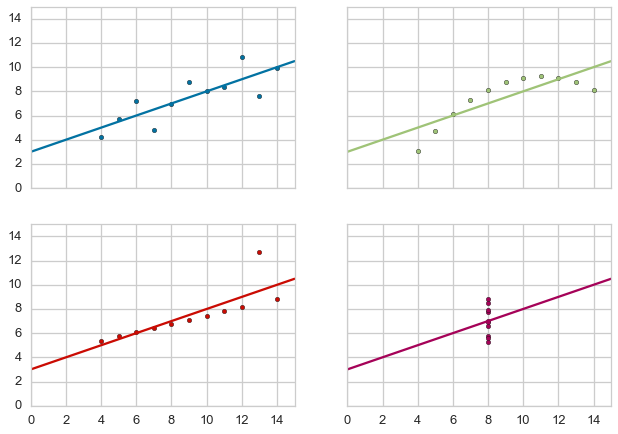
Load Datasets for Example Code¶
Yellowbrick has provided several datasets wrangled from the UCI Machine Learning Repository to present the following examples. If you haven’t downloaded the data, you can do so by running:
$ python download.py
In the same directory as the example notebook. Note that this will
create a directory called data that contains subdirectories with the
given data.
from download import download_all
## The path to the test data sets
FIXTURES = os.path.join(os.getcwd(), "data")
## Dataset loading mechanisms
datasets = {
"credit": os.path.join(FIXTURES, "credit", "credit.csv"),
"concrete": os.path.join(FIXTURES, "concrete", "concrete.csv"),
"occupancy": os.path.join(FIXTURES, "occupancy", "occupancy.csv"),
}
def load_data(name, download=True):
"""
Loads and wrangles the passed in dataset by name.
If download is specified, this method will download any missing files.
"""
# Get the path from the datasets
path = datasets[name]
# Check if the data exists, otherwise download or raise
if not os.path.exists(path):
if download:
download_all()
else:
raise ValueError((
"'{}' dataset has not been downloaded, "
"use the download.py module to fetch datasets"
).format(name))
# Return the data frame
return pd.read_csv(path)
Feature Analysis¶
Feature analysis visualizers are designed to visualize instances in data space in order to detect features or targets that might impact downstream fitting. Because ML operates on high-dimensional data sets (usually at least 35), the visualizers focus on aggregation, optimization, and other techniques to give overviews of the data. It is our intent that the steering process will allow the data scientist to zoom and filter and explore the relationships between their instances and between dimensions.
At the moment we have three feature analysis visualizers implemented:
- Rank2D: rank pairs of features to detect covariance
- RadViz: plot data points along axes ordered around a circle to detect separability
- Parallel Coordinates: plot instances as lines along vertical axes to detect clusters
Feature analysis visualizers implement the Transformer API from
Scikit-Learn, meaning they can be used as intermediate transform steps
in a Pipeline (particularly a VisualPipeline). They are
instantiated in the same way, and then fit and transform are called on
them, which draws the instances correctly. Finally poof or show
is called which displays the image.
# Feature Analysis Imports
# NOTE that all these are available for import from the `yellowbrick.features` module
from yellowbrick.features.rankd import Rank2D
from yellowbrick.features.radviz import RadViz
from yellowbrick.features.pcoords import ParallelCoordinates
Rank2D¶
Rank1D and Rank2D evaluate single features or pairs of features using a variety of metrics that score the features on the scale [-1, 1] or [0, 1] allowing them to be ranked. A similar concept to SPLOMs, the scores are visualized on a lower-left triangle heatmap so that patterns between pairs of features can be easily discerned for downstream analysis.
# Load the classification data set
data = load_data('credit')
# Specify the features of interest
features = [
'limit', 'sex', 'edu', 'married', 'age', 'apr_delay', 'may_delay',
'jun_delay', 'jul_delay', 'aug_delay', 'sep_delay', 'apr_bill', 'may_bill',
'jun_bill', 'jul_bill', 'aug_bill', 'sep_bill', 'apr_pay', 'may_pay', 'jun_pay',
'jul_pay', 'aug_pay', 'sep_pay',
]
# Extract the numpy arrays from the data frame
X = data[features].as_matrix()
y = data.default.as_matrix()
# Instantiate the visualizer with the Covariance ranking algorithm
visualizer = Rank2D(features=features, algorithm='covariance')
visualizer.fit(X, y) # Fit the data to the visualizer
visualizer.transform(X) # Transform the data
visualizer.poof() # Draw/show/poof the data
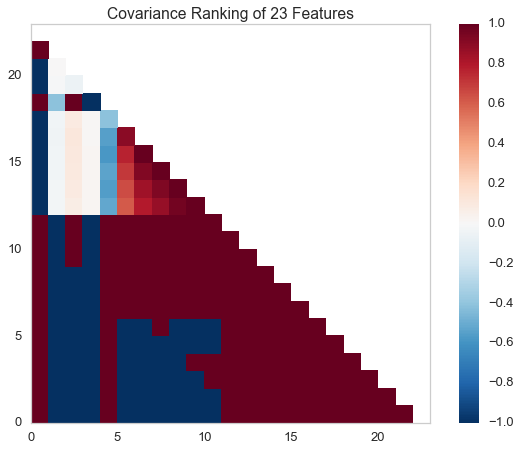
# Instantiate the visualizer with the Pearson ranking algorithm
visualizer = Rank2D(features=features, algorithm='pearson')
visualizer.fit(X, y) # Fit the data to the visualizer
visualizer.transform(X) # Transform the data
visualizer.poof() # Draw/show/poof the data
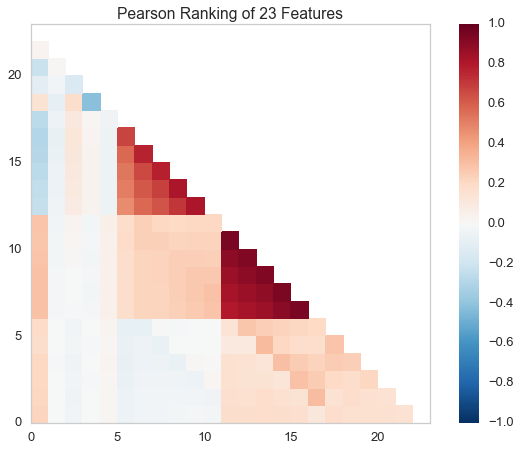
RadViz¶
RadViz is a multivariate data visualization algorithm that plots each feature dimension uniformely around the circumference of a circle then plots points on the interior of the circle such that the point normalizes its values on the axes from the center to each arc. This meachanism allows as many dimensions as will easily fit on a circle, greatly expanding the dimensionality of the visualization.
Data scientists use this method to dect separability between classes. E.g. is there an opportunity to learn from the feature set or is there just too much noise?
# Load the classification data set
data = load_data('occupancy')
# Specify the features of interest and the classes of the target
features = ["temperature", "relative humidity", "light", "C02", "humidity"]
classes = ['unoccupied', 'occupied']
# Extract the numpy arrays from the data frame
X = data[features].as_matrix()
y = data.occupancy.as_matrix()
# Instantiate the visualizer
visualizer = RadViz(classes=classes, features=features)
visualizer.fit(X, y) # Fit the data to the visualizer
visualizer.transform(X) # Transform the data
visualizer.poof() # Draw/show/poof the data
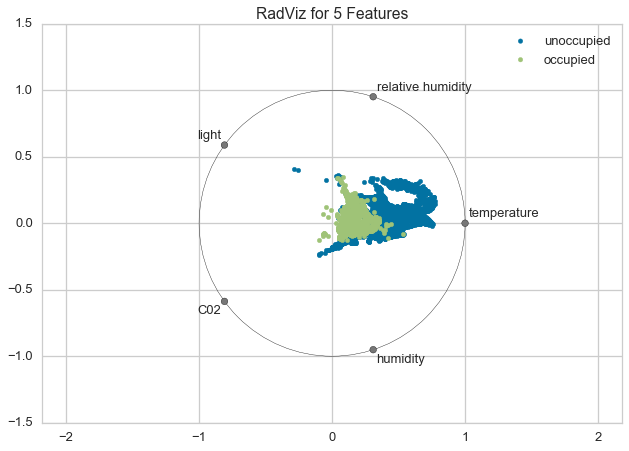
For regression, the RadViz visualizer should use a color sequence to display the target information, as opposed to discrete colors.
Parallel Coordinates¶
Parallel coordinates displays each feature as a vertical axis spaced evenly along the horizontal, and each instance as a line drawn between each individual axis. This allows many dimensions; in fact given infinite horizontal space (e.g. a scrollbar) an infinite number of dimensions can be displayed!
Data scientists use this method to detect clusters of instances that have similar classes, and to note features that have high varaince or different distributions.
# Load the classification data set
data = load_data('occupancy')
# Specify the features of interest and the classes of the target
features = ["temperature", "relative humidity", "light", "C02", "humidity"]
classes = ['unoccupied', 'occupied']
# Extract the numpy arrays from the data frame
X = data[features].as_matrix()
y = data.occupancy.as_matrix()
# Instantiate the visualizer
visualizer = ParallelCoordinates(classes=classes, features=features)
visualizer.fit(X, y) # Fit the data to the visualizer
visualizer.transform(X) # Transform the data
visualizer.poof() # Draw/show/poof the data
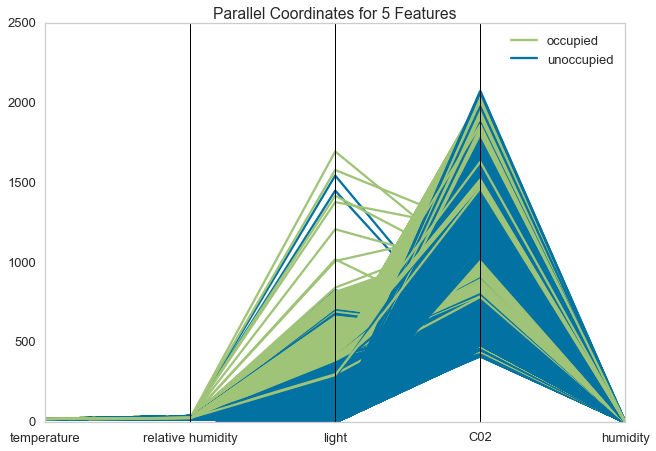
Regressor Evaluation¶
Regression models attempt to predict a target in a continuous space. Regressor score visualizers display the instances in model space to better understand how the model is making predictions. We currently have implemented two regressor evaluations:
- Residuals Plot: plot the difference between the expected and actual values
- Prediction Error: plot expected vs. the actual values in model space
Estimator score visualizers wrap Scikit-Learn estimators and expose
the Estimator API such that they have fit(), predict(), and
score() methods that call the appropriate estimator methods under
the hood. Score visualizers can wrap an estimator and be passed in as
the final step in a Pipeline or VisualPipeline.
# Regression Evaluation Imports
from sklearn.linear_model import Ridge, Lasso
from sklearn.cross_validation import train_test_split
from yellowbrick.regressor import PredictionError, ResidualsPlot
Residuals Plot¶
A residual plot shows the residuals on the vertical axis and the independent variable on the horizontal axis. If the points are randomly dispersed around the horizontal axis, a linear regression model is appropriate for the data; otherwise, a non-linear model is more appropriate.
# Load the data
df = load_data('concrete')
feature_names = ['cement', 'slag', 'ash', 'water', 'splast', 'coarse', 'fine', 'age']
target_name = 'strength'
# Get the X and y data from the DataFrame
X = df[feature_names].as_matrix()
y = df[target_name].as_matrix()
# Create the train and test data
X_train, X_test, y_train, y_test = train_test_split(X, y, test_size=0.2)
# Instantiate the linear model and visualizer
ridge = Ridge()
visualizer = ResidualsPlot(ridge)
visualizer.fit(X_train, y_train) # Fit the training data to the visualizer
visualizer.score(X_test, y_test) # Evaluate the model on the test data
g = visualizer.poof() # Draw/show/poof the data
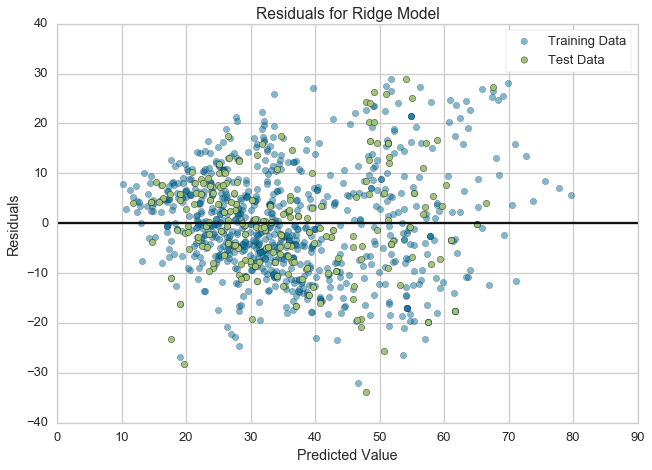
Prediction Error Plot¶
Plots the actual targets from the dataset against the predicted values generated by our model. This allows us to see how much variance is in the model. Data scientists diagnose this plot by comparing against the 45 degree line, where the prediction exactly matches the model.
# Load the data
df = load_data('concrete')
feature_names = ['cement', 'slag', 'ash', 'water', 'splast', 'coarse', 'fine', 'age']
target_name = 'strength'
# Get the X and y data from the DataFrame
X = df[feature_names].as_matrix()
y = df[target_name].as_matrix()
# Create the train and test data
X_train, X_test, y_train, y_test = train_test_split(X, y, test_size=0.2)
# Instantiate the linear model and visualizer
lasso = Lasso()
visualizer = PredictionError(lasso)
visualizer.fit(X_train, y_train) # Fit the training data to the visualizer
visualizer.score(X_test, y_test) # Evaluate the model on the test data
g = visualizer.poof() # Draw/show/poof the data
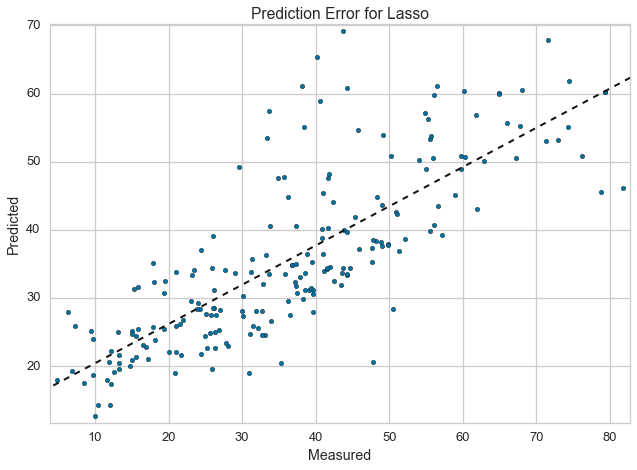
Classifier Evaluation¶
Classification models attempt to predict a target in a discrete space, that is assign an instance of dependent variables one or more categories. Classification score visualizers display the differences between classes as well as a number of classifier-specific visual evaluations. We currently have implemented three classifier evaluations:
- ClassificationReport: Presents the confusion matrix of the classifier as a heatmap
- ROCAUC: Presents the graph of receiver operating characteristics along with area under the curve
- ClassBalance: Displays the difference between the class balances and support
Estimator score visualizers wrap Scikit-Learn estimators and expose the Estimator API such that they have fit(), predict(), and score() methods that call the appropriate estimator methods under the hood. Score visualizers can wrap an estimator and be passed in as the final step in a Pipeline or VisualPipeline.
# Classifier Evaluation Imports
from sklearn.naive_bayes import GaussianNB
from sklearn.linear_model import LogisticRegression
from sklearn.ensemble import RandomForestClassifier
from sklearn.cross_validation import train_test_split
from yellowbrick.classifier import ClassificationReport, ROCAUC, ClassBalance
Classification Report¶
The classification report visualizer displays the precision, recall, and F1 scores for the model. Integrates numerical scores as well color-coded heatmap in order for easy interpretation and detection.
# Load the classification data set
data = load_data('occupancy')
# Specify the features of interest and the classes of the target
features = ["temperature", "relative humidity", "light", "C02", "humidity"]
classes = ['unoccupied', 'occupied']
# Extract the numpy arrays from the data frame
X = data[features].as_matrix()
y = data.occupancy.as_matrix()
# Create the train and test data
X_train, X_test, y_train, y_test = train_test_split(X, y, test_size=0.2)
# Instantiate the classification model and visualizer
bayes = GaussianNB()
visualizer = ClassificationReport(bayes, classes=classes)
visualizer.fit(X_train, y_train) # Fit the training data to the visualizer
visualizer.score(X_test, y_test) # Evaluate the model on the test data
g = visualizer.poof() # Draw/show/poof the data
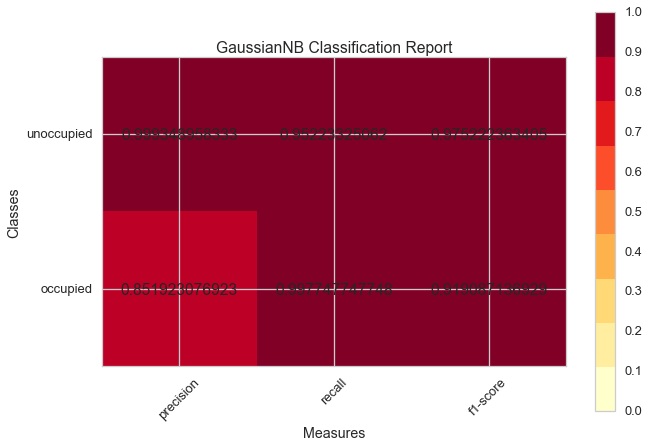
ROCAUC¶
Plot the ROC to visualize the tradeoff between the classifier’s sensitivity and specificity.
# Load the classification data set
data = load_data('occupancy')
# Specify the features of interest and the classes of the target
features = ["temperature", "relative humidity", "light", "C02", "humidity"]
classes = ['unoccupied', 'occupied']
# Extract the numpy arrays from the data frame
X = data[features].as_matrix()
y = data.occupancy.as_matrix()
# Create the train and test data
X_train, X_test, y_train, y_test = train_test_split(X, y, test_size=0.2)
# Instantiate the classification model and visualizer
logistic = LogisticRegression()
visualizer = ROCAUC(logistic)
visualizer.fit(X_train, y_train) # Fit the training data to the visualizer
visualizer.score(X_test, y_test) # Evaluate the model on the test data
g = visualizer.poof() # Draw/show/poof the data
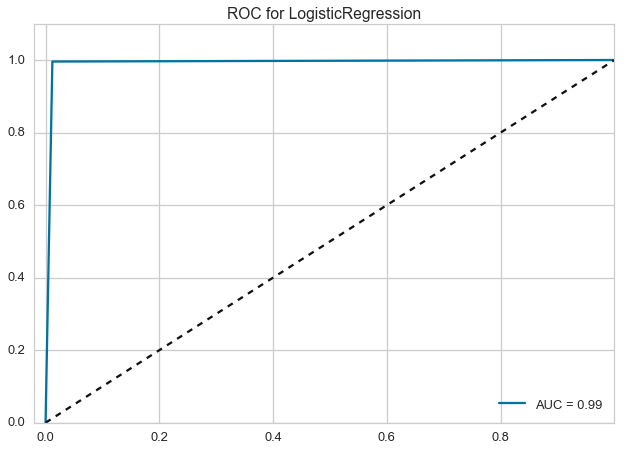
ClassBalance¶
Class balance chart that shows the support for each class in the fitted classification model.
# Load the classification data set
data = load_data('occupancy')
# Specify the features of interest and the classes of the target
features = ["temperature", "relative humidity", "light", "C02", "humidity"]
classes = ['unoccupied', 'occupied']
# Extract the numpy arrays from the data frame
X = data[features].as_matrix()
y = data.occupancy.as_matrix()
# Create the train and test data
X_train, X_test, y_train, y_test = train_test_split(X, y, test_size=0.2)
# Instantiate the classification model and visualizer
forest = RandomForestClassifier()
visualizer = ClassBalance(forest, classes=classes)
visualizer.fit(X_train, y_train) # Fit the training data to the visualizer
visualizer.score(X_test, y_test) # Evaluate the model on the test data
g = visualizer.poof() # Draw/show/poof the data
